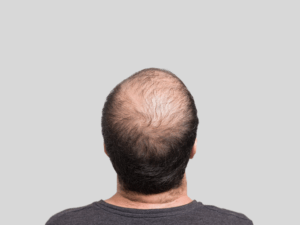Reference: International Journal of Molecular Sciences
Male pattern baldness, a widespread hair condition, affects millions globally. Its primary cause is linked to the increased scalp levels of a male hormone known as dihydrotestosterone (DHT). DHT’s interaction with hair follicle receptors leads to the thinning and eventual loss of hair.
Current treatments mainly involve topical Minoxidil applications and oral Finasteride doses. Despite their popularity, these solutions don’t guarantee success and have been associated with side effects in some cases.
The prevailing theory suggests that DHT triggers hair loss by activating a specific signaling pathway called “TGF-β1/SMAD3” in the body. This pathway is intricately connected to a series of biochemical reactions leading to “cell apoptosis” or cell death.
Recent research highlights a groundbreaking discovery: the microRNA “miR-122-5p” within stem cell exosomes. This particular microRNA can neutralize the excessive activation of TGF-β1/SMAD3 caused by DHT, offering a protective shield for hair follicle cells against apoptosis.
Animal studies underscore the potential of stem cell exosomes enriched with miR-122-5p in combating male pattern baldness, paving the way for optimistic future clinical applications.
As the exploration of exosomes in clinical settings progresses, there’s growing anticipation for their integration with existing treatments like Minoxidil and Finasteride. This innovative approach could herald a more comprehensive and effective solution for tackling male pattern baldness, promising a new era of hair loss therapy.
2024-05-24
Chronic Kidney Disease (CKD) is increasingly recognized as a significant health concern worldwide. According to a recent report in The Lancet Regional Health, as of 2022, between 9.1% and 13.4% of the global population suffers from CKD.A promising avenue for treating CKD, particularly in reducing
2024-04-24
Risk factors for hearing loss include ear infections, prolonged exposure to high-frequency noise, and unhealthy lifestyle habits, which can cause irreversible damage. In daily life, sounds enter the cochlea as vibrations, where they are transformed into auditory signals by hair cells and then transmitted by
2024-03-27
This groundbreaking study shines a light on the exosomes present in these muscle-secreted humoral factors. This compelling evidence underscores the potential of Myo-EVs in facilitating bone repair and restoring bone health, marking a significant stride in osteoporosis treatment.
2024-03-13
As the exploration of exosomes in clinical settings progresses, there's growing anticipation for their integration with existing treatments like Minoxidil and Finasteride. This innovative approach could herald a more comprehensive and effective solution for tackling male pattern baldness, promising a new era of hair loss
2024-02-02
Overexposure to UV rays stimulates the production of free radicals, leading to wrinkles, spots, and dullness. Therefore, it is essential to use sunscreen and engage in proper skincare to prevent and repair the signs of skin aging.
2024-01-05
Extracellular vesicles, including exosomes and microvesicles, are an important medium for intercellular communication, with nearly all cells secreting these vesicles. The research team compared aging muscle stem cells cultured with young serum to those with young serum depleted of extracellular vesicles, observing the impact of
2023-12-19
Biologically and medically speaking, immune cells activated after transplantation continuously attack hematopoietic tissues and ocular epithelial tissues, including the cornea, conjunctiva, and lacrimal glands, causing widespread inflammation.








